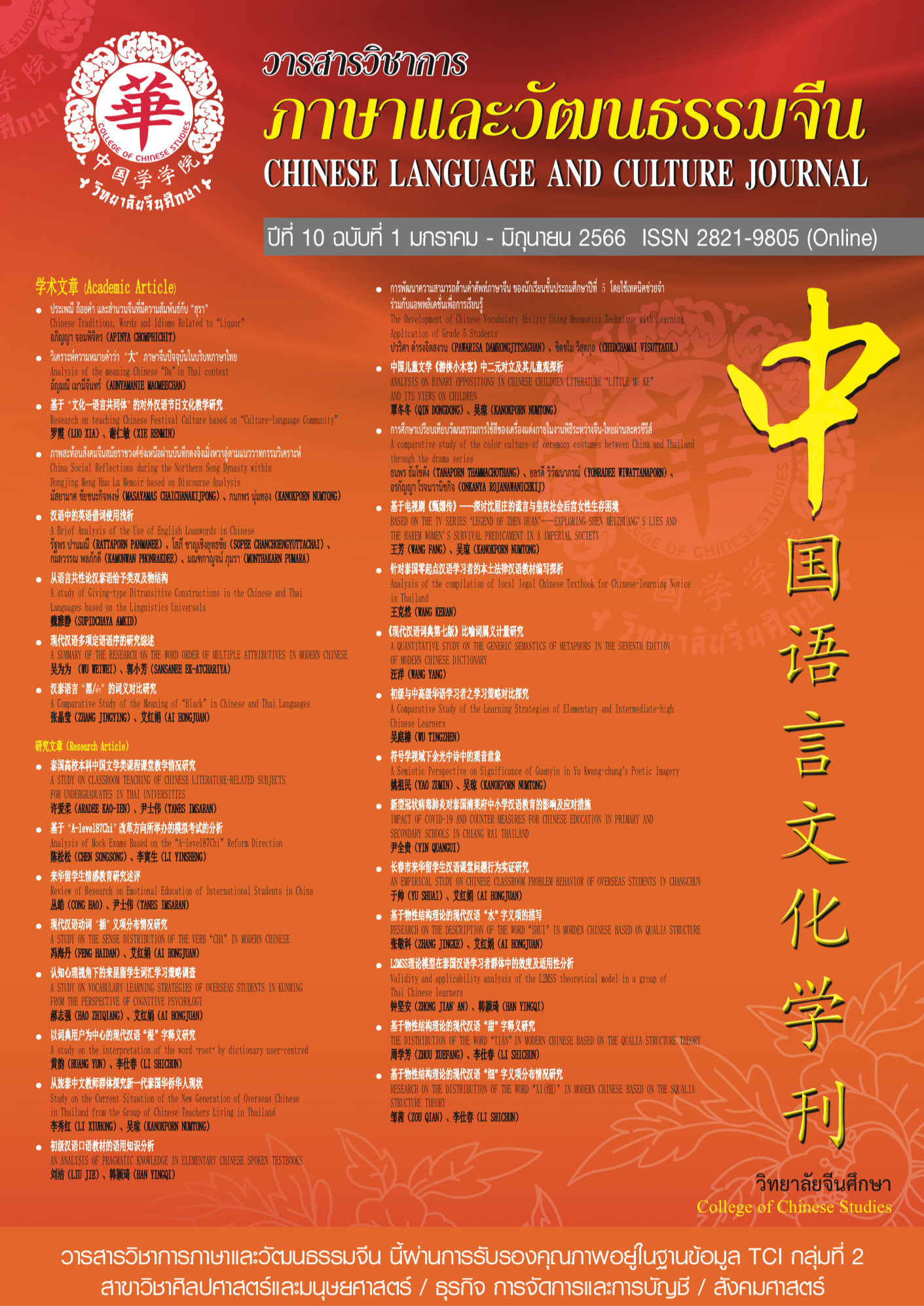A comparative study of the color culture of ceremony costumes between China and Thailand through the drama series
Keywords:
Culture, Color-costumes, Wedding ceremony, Funeral ceremonyAbstract
The aim of this paper is to study and analyzes the cultural differences in the colors reflected in the wedding and funeral costumes between China and Thailand through the scenes of the episode, the color of the ceremonial clothing and the choice of clothing color.
From a case study of 8 Chinese -Thai dramas, it is found that the costume colors in Chinese -Thai weddings are the same in terms of using colorful colors or maintaining auspicious meanings. Even if black or white is used, these two colors do not have the same negative connotations as funerals, and the difference is that Chinese weddings are dominated by red. Because the Chinese consider red to be an auspicious color, brightly colored clothes or different colored fabrics are often worn in Thai wedding ceremonies. The colors of the funeral ceremonies in China and Thailand are both black and white, which also implies similar meanings, that is, sadness, reluctance, and respect for the dead. Linen clothing in China also refers to the clothes worn by relatives of the deceased according to their closeness to the deceased. At funerals in Thailand, both black and white costumes are used. Today, black and white have changed meanings, and no meaning is given to convey kinship or age range, reflecting the belief that the idea has changed over time.
References
กนกกร สุขศิริวัฒนโรจน์. (2558). ความเชื่อเรื่องสีแดงของชาวจีน. (ปริญญาบัณฑิต). มหาวิทยาลัยศิลปากร,กรุงเทพมหานคร.
เขมภร เนตรทิวากร. (2557). การเพิ่มรูปแบบของการจัดงานแต่งงานของโรงแรมแม่น้ำ รามาดาพลาซ่า.กรุงเทพมหานคร: มหาวิทยาลัยสยาม.
เฉลิมชัย สุวรรณวัฒนา. (2553). สีในวัฒนธรรมคติความเชื่อของไทย. นครปฐม: บัณฑิตวิทยาลัย มหาวิทยาลัยศิลปากร.
ชาติชาย อนุกูล. (2552). วัฒนธรรมการใช้สีในสังคมไทย. วารสารวิชาการวไลยอลงกรณ์, (4)2: 34.
ณัฐชนา นวลยัง. (2559). เครื่องแต่งกายที่เป็นสื่อสัญลักษณ์ในงานทัศนศิลป์ไทยตั้งแต่ปี พ.ศ. 2544-2557.นครปฐม: บัณฑิตวิทยาลัย มหาวิทยาลัยศิลปากร.
ติณณา อุดม. (2560). การออกแบบชุดเจ้าสาวจากผ้าทอเกาะยอลายราชวัตรด้วยเทคนิคเลเซอร์คัท. (วิทยานิพนธ์ปริญญามหาบัณฑิต). มหาวิทยาลัยเทคโนโลยีราชมงคลพระนคร.กรุงเทพมหานคร.
ธรรมพร สุขมี. 2559. ประเพณีงานศพ: กระบวนการกลายเป็นสินค้าภายใต้กระแสบริโภคนิยม. (วิทยานิพนธปริญญามหาบัณฑิต). มหาวิทยาลัยสงขลานครินทร์, สงขลา.
รัชฏาพร พงษ์ราย. (2560). วิวาห์. (ปริญญาบัณฑิต). มหาวิทยาลัยเทคโนโลยีราชมงคลรัตนโกสินทร์, นครปฐม.
รัตนา จันทรสารโสภณ และ กิติกา กรชาลกุล. (2564). ชุดกี่เพ้ากับวิวัฒนาการการแต่งกายของชาวจีน. วารสารวิชาการภาษาและวัฒนธรรมจีน, (8)1: 73.
ศิริรัตน์ บุญสำอาง, สุกัญญา อุดแควและภาณุวัฒน์ สกุลสืบ. (2563). การศึกษาองค์ประกอบของพิธีกรรมในพิธีแต่งงานของชาวปกาเกอะญอหมู่บ้านสันโป่ง ตำบลเสริมกลาง อำเภอเสริมงาม จังหวัดลำปาง. วารสารมังรายสาร สถาบันภาษาและวัฒนธรรมนานาชาติ มหาวิทยาลัยราชภัฎเชียงราย, (8)1:15
胡玉华.中国丧服尚白礼俗[J].清华大学.寻根, 2007,(02):1-3.
龙晓添.丧礼的服色[J].广西师范大学.文史知识, 2015,(07):1-7.
罗娟·吴亦苇.中国服饰色彩的符号作用[J].南昌航空大学,广西轻工业. 2010,26(10):1-2.
谭苗.颜色中的文化差异———中、越、泰基本颜色的象征意义对比研究[J].桂林理工大学外国语学院,2015,28(16):193-194.
孙希如.汉民族丧服色彩的民俗学研究——以浙江省金华市寺平村丧服色彩民俗为例 [D].浙江:浙江师范大学,2012.
张思远.服饰色彩研究[D].河北:河北大学,2008.
Downloads
Published
How to Cite
Issue
Section
License
Copyright (c) 2023 Chinese Language and Culture Journal

This work is licensed under a Creative Commons Attribution-NonCommercial-NoDerivatives 4.0 International License.
บทความที่ได้รับการตีพิมพ์เป็นลิขสิทธิ์ของวารสารภาษาและวัฒนธรรมจีน มหาวิทยาลัยหัวเฉียวเฉลิมพระเกียรติ
บทความใน “วารสารวิชาการภาษาและวัฒนธรรมจีน” เป็นทรรศนะของผู้เขียนโดยเฉพาะ กองบรรณาธิการไม่มีส่วนในความคิดเห็นในข้อเขียนเหล่านั้น




